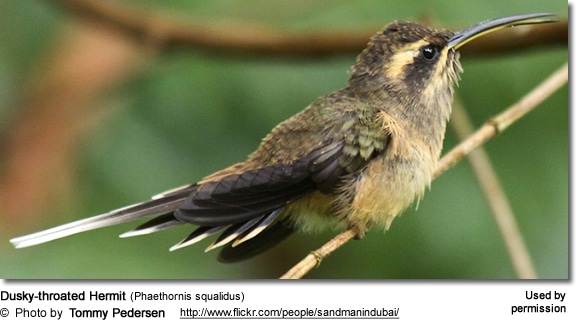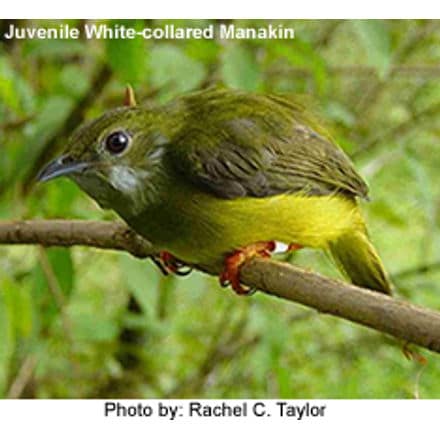Dusky-throated Hermit
The Dusky-throated Hermits (Phaethornis squalidus) – also known as Sooty-throated Hermit – is a South American hummingbird that is endemic to the humid Atlantic forests in south-eastern Brazil; specifically, this species is found in south Minas Gerais and Espírito Santo to Santa Catarina.
It formerly included the Streak-throated Hermit as a subspecies.
Alternate (Global) Names
Spanish: Ermitaño Chico Bronceado, Ermitaño Escuálido … French: Ermite terne … Italian: Colibrì del sole golabruna … Czech: Kolibrík cernohrdlý, kolib?ík temnohrdlý ,… Danish: Sodstrubet Eremit … German: Schwarzkehleremit, Schwarzkehl-Eremit … Finnish: partaerakkokolibri, Suttuerakkokolibri … Japanese: nodoguroyumihachidori … Dutch: Bruinkeelheremietkolibrie, Bruinkeel-heremietkolibrie … Norwegian: Smusseremitt … Polish: pustelnik skromny … Portuguese: Rabo-branco-amarelo, rabo-branco-miúdo, rabo-branco-pequeno … Russian: ??????????? ????????? ??????? … Slovak: slnecnícek ciernohrdlý … Swedish: Sotstrupig eremit
Description
This small hermit has a total length of approximately 3.5 inches or 9 cm.
The underplumage is pale buff. It has dark streaks on its throat.
Reproduction
Courting
Hummingbirds in general are solitary and neither live nor migrate in flocks; and there is no pair bond for this species – the male’s only involvement in the reproductive process is the actual mating with the female.
The males of many Hermit species form leks and congregate on traditional display grounds, where females visit to choose a mate. He will separate from the female immediately after copulation. One male may mate with several females. In all likelihood, the female will also mate with several males. The males do not participate in choosing the nest location, building the nest or raising the chicks.
Hummingbird Resources
- Hummingbird Information
- Hummingbird Amazing Facts
- Attracting Hummingbirds to Your Garden
- Hummingbird Species
- Feeding Hummingbirds
Nesting
The female Dusky-throated Hermits is responsible for building the remarkable cone-shaped nest which hangs by a single strong string of spiders’ silk and/or rootlets from some overhead support, which could be a branch or the underside of the broad leaves of, for example, Heliconia plants, banana trees or ferns about 3 – 6 ft (1 – 2 m) above ground. However, these unusual nests have been found beneath bridges, in highway culverts and even hanging from roofs inside dark buildings. The nest is often near a stream or waterfall. It is constructed out of plant fibers woven together and green moss on the outside for camouflage in a protected location.
She lines the nest with soft plant fibers, animal hair, and feathers down, and strengthens the structure with spider webbing and other sticky material, giving it an elastic quality to allow it to stretch to double its size as the chicks grow and need more room.
The average clutch consists of two white eggs, which she incubates alone, while the male defends his territory and the flowers he feeds on (although hermit males tend to be less aggressive than the males of other hummingbird species).
The young are born blind, immobile, and without any down.
The female alone protects and feeds the chicks with regurgitated food (mostly partially digested insects since nectar is an insufficient source of protein for the growing chicks). The female pushes the food down the chicks’ throats with her long bill directly into their stomachs.
As is the case with other hummingbird species, the chicks are brooded only the first week or two and are left alone even on cooler nights after about 12 days – probably due to the small nest size. The chicks leave the nest when they are about 20 days old.


Diet / Feeding
The Dusky-throated Hermits primarily feed on nectar taken from a variety of brightly colored, scented small flowers of trees, herbs, shrubs and epiphytes.





